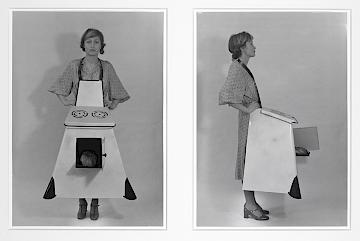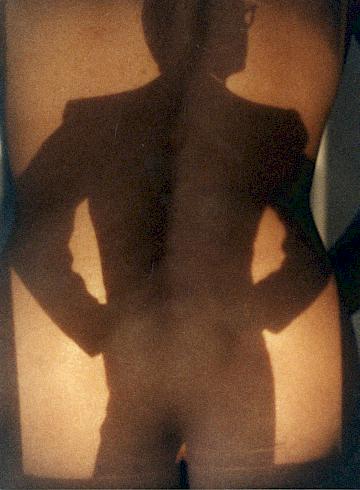Abigail Solomon-Godeau et al. - Birgit Jürgenssen The omission of Jürgenssen in American critical and curatorial circles is perplexing, for hers is among the most trenchant work in the feminist-art canon.
The publication next month of a monograph on Birgit Jürgenssen marks the first in-depth consideration of the career of the Austrian artist published in English. The book arrives six years after her death and on the sixtieth anniversary of her birth--significant recognition for an artist many English-speaking audiences know little, if anything, about. Jürgenssen, like her better-known compatriot Valie Export, is part of the pioneering generation of feminist artists. In three decades of prolific production--from the early '70s through the late '90s--she utilized nearly every media to unravel the linguistic strictures around gender and identity. But unlike Export, Jürgenssen is a latecomer to the feminist-art sisterhood, which largely comprises Americans. Her lone solo outing in the United States was at Jack Tilton Gallery in 1984, and, even recently, she wasn't included in "Wack! Art and the Feminist Revolution," an exhibition organized by the Museum of Contemporary Art, Los Angeles, that sought to examine the international history and legacy of feminist art. mehr
The omission of Jürgenssen in American critical and curatorial circles is perplexing, for hers is among the most trenchant work in the feminist-art canon. What she did do, however, was performance art. There is nothing in Jürgenssen's oeuvre approximating Yoko Ono's Cut Piece, 1965, or Carolee Schneemann's Interior Scroll, 1975. And where Export, in Tapp und Tastkino (Tap and Touch Cinema), 1968, strapped a "movie theater" box to her bare torso, headed out into the street, and encouraged passersby to feel her breasts while looking her in the eye, Jürgenssen, in Hausfrauen-Küchenschürze (ph1578) (Housewives' Kitchen Apron), 1975, photographed herself with a stove-apron hung round her neck, literalizing the burden borne by housewives in a patriarchal society. (It's worth noting that the stove seems sexualized: Its burners resemble breasts, and a loaf of bread pokes provocatively into/out of the small oven door.) As Gabriele Schor cites in her essay for the book, Jürgenssen felt an artistic kinship with Meret Oppenheim and Louise Bourgeois, noting that their art was "more poetic, less direct, and more subversive." These are also apt descriptors of Jürgenssen's work, which, with its rapt and frequently humorous deconstruction of gendered linguistics, becomes a different breed of feminist art, replacing confrontation and guerrilla practices with a cerebral subtlety.
(Housewives' Kitchen Apron), 1975, photographed herself with a stove-apron hung round her neck, literalizing the burden borne by housewives in a patriarchal society. (It's worth noting that the stove seems sexualized: Its burners resemble breasts, and a loaf of bread pokes provocatively into/out of the small oven door.) As Gabriele Schor cites in her essay for the book, Jürgenssen felt an artistic kinship with Meret Oppenheim and Louise Bourgeois, noting that their art was "more poetic, less direct, and more subversive." These are also apt descriptors of Jürgenssen's work, which, with its rapt and frequently humorous deconstruction of gendered linguistics, becomes a different breed of feminist art, replacing confrontation and guerrilla practices with a cerebral subtlety.
If the artist's body is elided by the cooking stove in Hausfrauen-Küchenschürze, FRAU (ph1037) (WOMAN) , 1972, presents a more literal interpretation of the same idea. In four photographs, Jürgenssen, dressed in a black leotard, positions her body to spell out frau. The actual letters are superimposed on each pose in red. The static quality of the images makes her positions seem obligatory: These are not the natural movements of her body, but the hard and fast lines of the overlying letters dictate she twist and bend in accordance. We recognize the word frau and see that it pertains to Jürgenssen (or Jürgenssen to it), but we can now also see that the relationship is artificial. It brings to mind Simone de Beauvoir's famous statement, written more than two decades earlier, "One is not born, but rather becomes, a woman." FRAU also prefigures Martha Rosler's exploration of language's innate subjectivity in her 1975 video Semiotics of the Kitchen, in which her deliberate, exaggerated way of demonstrating kitchen implements introduces a sense of irrationality between each object and its cultural signifier.
(WOMAN) , 1972, presents a more literal interpretation of the same idea. In four photographs, Jürgenssen, dressed in a black leotard, positions her body to spell out frau. The actual letters are superimposed on each pose in red. The static quality of the images makes her positions seem obligatory: These are not the natural movements of her body, but the hard and fast lines of the overlying letters dictate she twist and bend in accordance. We recognize the word frau and see that it pertains to Jürgenssen (or Jürgenssen to it), but we can now also see that the relationship is artificial. It brings to mind Simone de Beauvoir's famous statement, written more than two decades earlier, "One is not born, but rather becomes, a woman." FRAU also prefigures Martha Rosler's exploration of language's innate subjectivity in her 1975 video Semiotics of the Kitchen, in which her deliberate, exaggerated way of demonstrating kitchen implements introduces a sense of irrationality between each object and its cultural signifier.
But Jürgenssen doesn't merely engage in the "pious show of unmasking" social constructs, the kind of cursory evaluation that Roland Barthes sought to move beyond. Her aim, however, wasn't, like Barthes's, to demystify signification but to destabilize and reconfigure it. "The fixing of language and the fixing of sexual identity go hand in hand," wrote Jacqueline Rose in her 1986 essay "Sexuality in the Field of Difference." "They rely on each other and share the same forms of instability and risk." Rose goes on to note how literary modernism's syntactic and narrative shifts extend to sexuality, resulting in "a type of murking of the sexual properties." In a similar fashion, many of Jürgenssen's works revolve around ironic wordplay, puns, and double meanings--the changeability of language and, thus, its ability to support any number of identities. The upshot of this detournement is significant: "If one can intervene in the idées recus that regulate everyday life," notes Elisabeth Bronfen in her essay, "then the cultural imagination also changes, and with it, the consciousness of the self that must inevitably be oriented to the words and images surrounding us."
An interesting example of Jürgenssen's linguistic acrobatics is her 1996 collaboration with Lawrence Weiner, I Met a Stranger, a book that combines her photographs with his text. In a majority of the photographs, Jürgenssen uses the body as a screen (or canvas) on which she projects shadows, images, and patterns, and many of these involve some form of doubling: the top half of what appears to be a saluting soldier is joined with the legs of a pinup girl (ph1751) ; two fingers of a woman's hand are covered with the image of two seahorses (a creature that takes part in a sexual role reversal during reproduction); two sphinxes face each other on a woman's belly across the page from a Janus-like female head (ph966)
; two fingers of a woman's hand are covered with the image of two seahorses (a creature that takes part in a sexual role reversal during reproduction); two sphinxes face each other on a woman's belly across the page from a Janus-like female head (ph966) ; the back view of a man is projected onto a woman's bare back (ph1730)
; the back view of a man is projected onto a woman's bare back (ph1730) . In these and other photographs, the body becomes a palimpsest, in which the various layers blur together. The small rectangular cutouts that precede each image initially suggest a sense of voyeurism, but any erotic satisfaction is stymied by this multiplicity. The text, which appears in fragments throughout the book and lacks punctuation, can be read a number of different ways, demonstrating Jürgenssen's belief that the narrative of identity isn't linear and that we experience our selves in others:
. In these and other photographs, the body becomes a palimpsest, in which the various layers blur together. The small rectangular cutouts that precede each image initially suggest a sense of voyeurism, but any erotic satisfaction is stymied by this multiplicity. The text, which appears in fragments throughout the book and lacks punctuation, can be read a number of different ways, demonstrating Jürgenssen's belief that the narrative of identity isn't linear and that we experience our selves in others:
>SweetIy met a stranger
& they looked at me
& they looked at me again
& again
I acknowledged the gaze
& they looked at me
again
I returned their attention
just one time
& they looked at me
as if for the first time
& I asked them for their name
The very modernist rejection of narrative convention and montage aesthetic that occurs in both the images and the text of I Met a Stranger mirrors the reversals and ambivalence of a book that appeared sixty-six years earlier, Claude Cahun's Disavowels. The French artist and writer famously changed genders as frequently and as easily as she changed costumes and, like Jürgenssen, viewed gender more as performance than as the means to self-identity. In her 1930 book of essays and photomontages, Cahun imagined a third sex: "Shuffle the cards. Masculine? Feminine? It depends on the situation. Neuter is the only gender that always suits me. If it existed in our language no one would be able to see my thought's vacillations." Echoing these sentiments, Jürgenssen wrote in a 2000 letter, "The question of self-identity today is no longer Who am I?, but rather, Where am I? . . . Gender-specific identity arises out of the space that people create within which to exist."